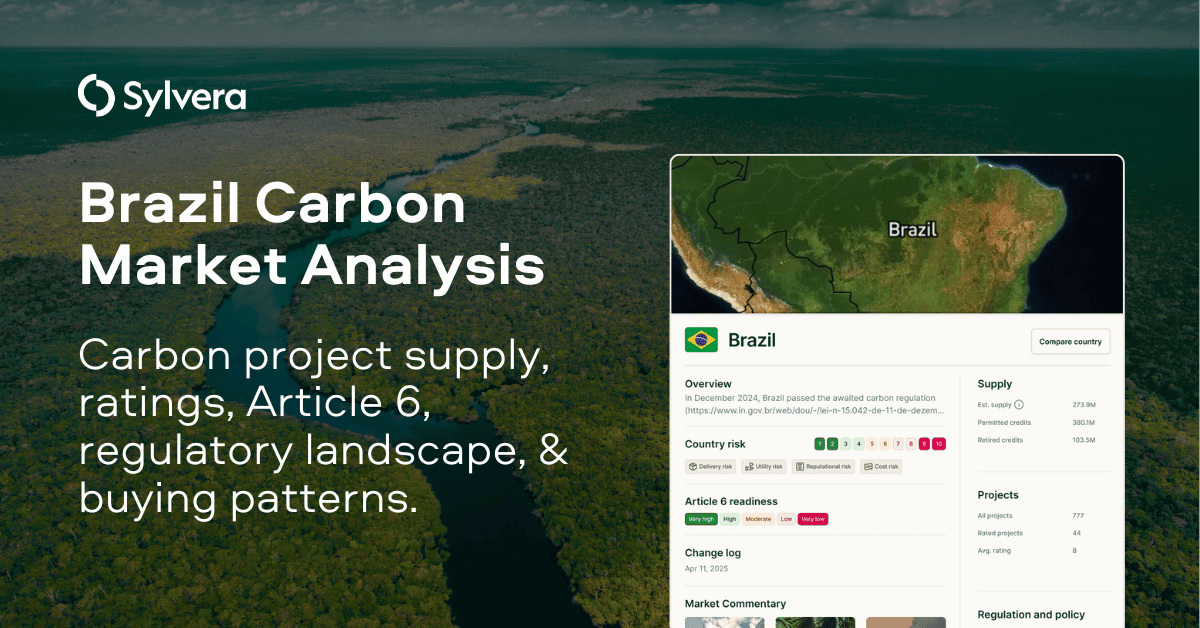“Over the years we’ve invested significantly in our field data team - focusing on producing trusted ratings. While this ensures the accuracy of our Ratings, it doesn’t allow the scale across the thousands of projects that buyers are considering.”
For more information on carbon credit procurement trends, read our "Key Takeaways for 2025" article. We share five, data-backed tips to improve your procurement strategy.

One more thing: Connect to Supply customers also get access to the rest of Sylvera's tools. That means you can easily see project ratings and evaluate an individual project's strengths, procure quality carbon credits, and even monitor project activity (particularly if you’ve invested at the pre-issuance stage.)
Book a free demo of Sylvera to see our platform's procurement and reporting features in action.
As Brazil hosts COP30, the country's carbon market is in the spotlight. This analysis examines Brazil's regulatory developments, risk profile, Article 6 readiness, and the key market trends shaping the country's carbon landscape.
Accelerated institutional support ahead of COP
Brazil has made swift moves to advance its climate leadership before hosting COP30. In the past few weeks, we've seen accelerated efforts to establish institutional support for carbon market activity.
- An important decision has been made to house the provisional secretariat for its national Emission Trading System (SBCE for its Portuguese acronym) within the Ministry of Finance (MoF).
- The establishment of the Department of Market Instruments and REDD+ (Dimer) marks a significant step toward operationalizing Brazil’s participation in international carbon trading under Article 6 of the Paris Agreement.
Follow our dedicated COP30 Hub to keep up to date with all the news relevant to carbon markets, with insights from our team on the ground in Belem.

Establishing robust institutional arrangements - whether by expanding existing bodies or developing new carbon institutions with clear mandates - a foundational step in creating an enabling environment for investment, providing market predictability and greater confidence.
Together, these developments signal Brazil’s growing commitment to expand its carbon market. For more on Host Country Article 6 readiness, see our recent whitepaper.

Brazil’s carbon credit markets: An overview
In December 2024, Brazil passed the much-awaited Law 15.042/2024, officially establishing the SBCE. Due to anticipated linkages between the SBCE and other carbon markets, the Law includes some provisions for the VCM and Article 6 markets and will rule key aspects related to carbon trading in the country. Key highlights of the law include:
- Established the SBCE as Brazil’s national compliance market
- Allows the use of domestic carbon credits (subject to yet to be defined quantitative and qualitative requirements) for compliance
- Addresses to some extent international trading in the VCM and Article 6 markets, due to anticipated linkages with the national SBCE
- Provides regulatory guidance for REDD+ projects
- Limits Article 6.2 authorization and corresponding adjustments (CAs) to credits generated under nationally accredited methodologies, raising questions around scope, eligibility, and market access for those seeking adjusted credits
Brazil also introduced a separate regulation supporting carbon capture and storage (CCS) projects; however, new requirements may introduce additional complexity and risk for project developers.
Brazil’s delivery risk analysis: Moderate
- Brazil has extensive experience hosting carbon projects and offers a supportive legal framework that provides oversight without intervening in the VCM.
- Efforts to establish a more supportive national carbon infrastructure and initiatives to enhance government effectiveness (as assessed by the World Bank) are the key levers that can be used to significantly reduce delivery risk and boost long-term confidence among buyers and investors.
Brazil’s reputational risk analysis: Moderate
- Brazil has been recognized for its efforts toward improving human and Indigenous Peoples and Local Communities (IPLCs) rights protection, a mandate primarily overseen by the National Foundation of Indigenous Peoples (FUNAI), a government body that establishes and carries out policies relating to IPLCs
- Media scrutiny of carbon projects has presented a challenge in the past, and underscores the strategic value of undertaking thorough due diligence and prioritizing high-quality projects whose robust environmental integrity and safeguards counterbalance and mitigate any reputational risks.
Brazil’s Article 6 readiness: Moderate
Brazil’s Article 6 readiness is characterized by different levels of progress under Article 6.2 and 6.4.
- Brazil’s Law 15.042/2024 recognizes Article 6.2 participation; however, it defers key processes to further regulation.
- The country lacks infrastructure to track authorizations and CAs and has neither defined a positive list of activities nor signed any Article 6.2 agreements with buyers. The recent establishment of the Dimer as the Article 6 authority may accelerate the country’s Article 6.2 progress by filling in these gaps.
- The country is relatively more advanced on Article 6.4, having submitted a Designated National Authority (DNA) and a participation form with a positive list of activities under the Paris Agreement Crediting Mechanism (PACM).
Brazil has hosted many projects under the Clean Development Mechanism (CDM); some have requested transition to the PACM and are pending approval.
Brazil carbon credit market: Headline numbers
Estimated carbon credit supply: 273.9 million
Retired carbon credits to date: 103.5 million
Issuing projects: 85
Sylvera-rated projects: 44
Average Sylvera Rating: B
Brazil carbon credit prices
Brazil's carbon credit market shows stark price differentiation across project types, reflecting varying perceptions of quality and risk.
ARR (Afforestation, Reforestation and Revegetation) projects in Brazil average $38.67 per credit.
REDD+ (Reducing Emissions from Deforestation and forest Degradation) projects average $5.54.
Landfill methane projects average $6.02.
Carbon credit rating to price premiums
Diving deeper into the REDD+ project type specifically, rating quality directly correlates with pricing power:
Brazilian REDD+ projects rated BBB achieve an average price of $9.44
Brazilian BB-rated REDD+ projects average $5.56
Brazilian B-rated REDD+ projects average $4.00
Brazil carbon credit issuance breakdown
Carbon credit project types
In terms of projects issued in Brazil in 2025, the project type breakdown shows:
Forestry and land use at 47%
Waste management at 29%
Household and community projects are emerging at 22% (a category more prominent in issuances than retirements, suggesting growing pipeline activity in this sector).
And renewable energy at 21%
At the project type level, REDD+ remains dominant at 45%, landfill methane is second at 29%, and hydropower stands third at 13%.
Eligibility
28% of newly issued credits qualify for CORSIA's first phase (subject to host country authorization).
Issuances by registry
Verra maintains its leading position at 70% of issuances, with Gold Standard at 30%.
Brazil carbon credit retirement breakdown
Carbon credit project types
In terms of Brazil carbon credit retirements in 2025, the breakdown by project type reflect the diversity that can be found in the country:
Forestry and land use leads at 48%
Followed by waste management at 27%
Renewable energy is at 25%
Within these categories, REDD+ projects (forestry) represent 46% of all retirements, with landfill methane at 26% and hydropower at 16%.
Eligibility
A notable trend is the rise in CORSIA-eligible retirements. Credits eligible (subject to host country corresponding adjustment or alternative insurance) for CORSIA’s first phase now represent 23% of retirements, up from 7% in 2024. This signals growing alignment with compliance obligations.
Retirements by registry
Verra dominates the registry landscape with 75% of retirements, while Gold Standard accounts for most of the remainder at 24%.
Brazil’s carbon credit market: Buying patterns
The global buyer interest in Brazilian carbon credits spans multiple industries, with international corporations and domestic Brazilian companies actively buying in the market.
Top 10 buyers of Brazilian carbon credits
Top 10 Brazil-based buyers (Projects not just from Brazil)
Among Brazilian companies themselves, purchasing strategies reflect their core business models and sustainability priorities.
Natura Cosmetics, a major Brazilian consumer goods and retail operator and largest Brazilian carbon credit retiree in 2025, takes a balanced approach with its portfolio split evenly between REDD+ and renewable energy credits - demonstrating a diversification strategy that addresses both forest protection and clean energy transitions. The company was the first emerging market business to achieve a VCMI Carbon Integrity Platinum Claim.
Petrobras, Brazil's energy giant, ranks second, focusing exclusively on forestry and land use projects, with 100% of its purchases going to REDD+ credits. This concentration suggests a strategic priority on nature-based solutions, potentially driven by both reputational considerations in addressing oil and gas operations and the competitive pricing of REDD+ credits.
Localiza Rent a Car ranks third and heavily weights renewable energy at 90.2% of its portfolio, with only 9.8% in REDD+ projects. This emphasis on renewable energy credits aligns logically with the company's automotive and mobility business, where energy transition and vehicle electrification represent core sustainability challenges.
Access carbon market insights first-hand
The data and insights in this analysis are drawn from Sylvera's Country Profiles and Market Intelligence tools - designed to help the market navigate policy risk, assess market opportunities, and make informed decisions.
Country Profiles provide comprehensive risk assessments across 40+ countries, evaluating delivery risk, reputational risk, utility risk, and Article 6 readiness.
Market Intelligence delivers real-time visibility into supply, demand, pricing, and buyer behavior. Users can analyze issuance and retirement trends by project type, registry, and eligibility (CORSIA, CCP, compliance schemes), while accessing pricing data that reveals quality premiums.
Get a demo to explore how Sylvera's tools and data can help you navigate evolving carbon markets.
Stay in the know ahead of COP30
Follow our dedicated COP30 Hub to keep up to date with all the news relevant to carbon markets, with insights from our team on the ground in Belem.

--
Data has been sourced from Sylvera’s Market Intelligence suite, featuring over 20,000 price estimates across 19 registries and 39,000 retirees.
Market Intelligence includes retirements and issuances between 1st January and 31st October 2025. The data is aggregated across major registries in the voluntary carbon market, including Verra, Gold Standard, American Carbon Registry, Climate Action Reserve, Puro, EcoRegistry, and BioCarbon Standard.















